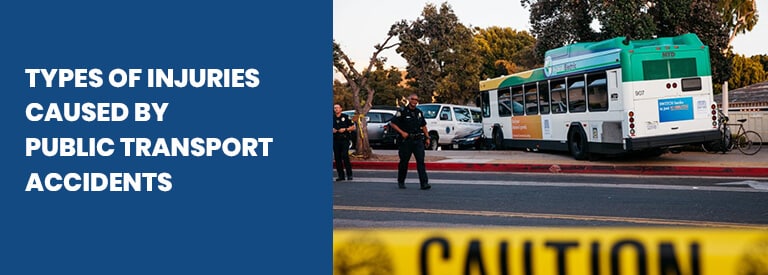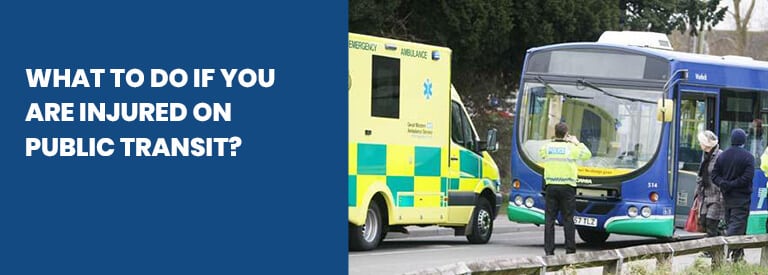How Often Are People Injured on Public Transit?
Public transit can be an effective way to get around the town, accomplish your errands and get to and from work. But what happens if you end up seriously injured as a result of public transit? Unfortunately, this has become a question that some people have had to answer in their lives by discovering that their debilitating injuries and impacts from the accident follow them for years to come. It is important to understand your rights and responsibilities when you have been hurt in an accident on mass transit.
Not every circumstance will enable you to file a personal injury claim to recover compensation but a prompt meeting with a dedicated attorney can make a big difference. People injured on public transit should evaluate their rights to file a lawsuit sooner rather than later as public transit accidents can change your life in big and dramatic ways. In Ontario, particularly in the greater Toronto area, you take advantage of public transit options provided by the Toronto Transit Commission, York Regional Transit, and GO Transit.
Public transit in Canada is generally considered a safe mode of transportation but accidents can still happen no matter how careful drivers and passengers are. It’s worth getting an idea of how often people can be hurt while commuting using public transit. If you or your loved one has suffered an injury due to a public transit accident, you can always consult with an experienced personal injury lawyer like the ones at Diamond & Diamond to explore your legal options.
How Often Do People Get Injured on Public Transit?
When the TTC released its CEO report in March 2019 it provided some data on the frequency of injuries that happen while on public transit. TTC options include a subway train, streetcar and bus.
According to that report, roughly one passenger injury is reported per one million passenger boardings. Per weekday there are 2.75 million passenger boardings on the TTC system so the weekly estimate for the injuries is just under 3 passenger injuries reported on weekdays.
When it comes to the frequency of traffic accidents and not the frequency of injuries, TTC reports that up to 10 accidents are reported daily for streetcars and buses. When stretched over a 3-year span, that equates to over 11,000 reports of accidents in total. According to the TTC report most of these streetcar and bus accidents are minor in nature and only a small percentage result was serious injuries. Note that these are numbers from TTC only, not counting those from YRT or GO Transit. Also these do not include injuries suffered by non-passengers who are involved in public transit accidents.
Types of Injuries Caused by Public Transport Accidents

Major accidents can include subway crashes, streetcar and bus crashes, and more. Due to the nature of these accidents some result in serious injuries and even catastrophic injuries, such as spinal cord injuries, brain injuries or soft tissue injuries.
Although these crashes are quite rare, they can be caused by collisions, maneuvering, such as when a driver suddenly brakes or when a driver suddenly swerves to avoid collision. Accidents can also be associated with boarding, such as slip and fall accidents when boarding a train, streetcar or bus.
What to Do If You Are Injured on Public Transit?

A couple of important steps can help to protect your tights and ensure your best possible chance to recover compensation after an accident. These include seeking medical attention immediately, getting a copy of the police report, requesting a copy of TTC’s video recording since the organization records video onboard trains and buses for passenger safety and consulting with a personal injury lawyer.
Talk to a Diamond & Diamond personal injury lawyer today if you or your loved one got hurt while riding TTC public transit (train, streetcar, or bus).
How to Reach Diamond & Diamond
Our public transit accident law firm has helped other victims who’ve been seriously injured in preventable accidents to recover compensation. You can learn more about our services by visiting any of our offices across Ontario, completing our online contact form or calling our 1-800 number for a free consultation. You can call at any time of day to get a response from an attorney.
PRO TIP :
“Don’t delay in filing your public transit injury claim — you have two years from the date of the accident to make it happen.”
FAQs on How Often Are People Injured on Public Transit
What are the special tort rules that apply to public transit accidents?
Although public transit accidents do fall under the general category of personal injury claims, they are not always treated exactly the same as your traditional vehicle accident claim. This is why it is important to retain a law firm that is familiar with these rules and can help explain it to you before you begin your case. Every motor vehicle insurance policy in the Ontario province includes entitlement to statutory accident benefits but recent updates to the insurance act now make it more difficult for a person who has been injured while riding a public transit vehicle to apply for SABS if it did not involve a direct collision with another motor vehicle. You can get compensation through this program for missed work, medical treatment, and non-earner benefits. You could also be eligible to sue the owner of the public transit vehicle, such as the TTC to recover compensation.
What are statutory accident benefits and how do they relate to public transit accidents?
In many cases of personal injury claims in Ontario, statutory accident benefits apply to victims of those accidents. However, you are only eligible to recover these in the event that you were hurt in a public transit accident if that involved a collision with another vehicle. For further questions on whether or not this applies to you or an individual case, it is beneficial to schedule a consultation with a trusted transit accident lawyer today.
What is TTC’s liability if I got injured by another passenger while on public transit?
If you are injured because of another TTC user’s conduct, the Better Tomorrow Act will restrict benefits that the TTC must pay out. You must pursue a claim of tort against the rider in question or your own insurance policy to recover compensation.